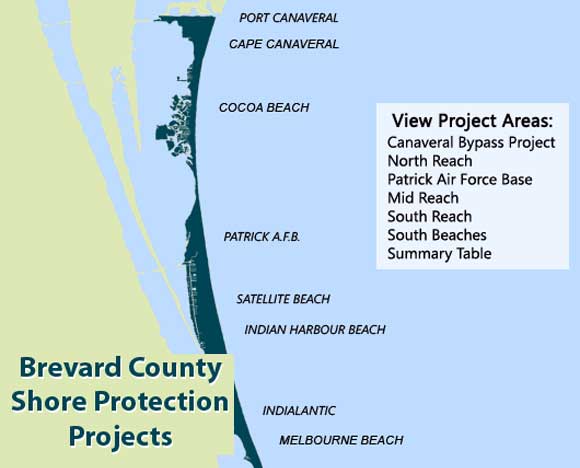Input From State, Federal Agencies and Public Led To Brevard Mid Reach Beach Mitigation Project
By Don Walker, Brevard County Communications Director // June 30, 2017
construction of artificial mitigation reefs underway

BREVARD COUNTY, FLORIDA – More than a decade of collaboration with multiple state and federal agencies, including the U.S. Fish and Wildlife Service, National Marine Fisheries Service, Florida Fish and Wildlife Commission and Florida Department of Environmental Protection, steered the design of Brevard County’s Mid Reach Beach Mitigation project, which is now underway east of the Satellite Beach shoreline.
Throughout this process, comments from both the public and agency scientists were addressed prior to plan approval.
The project carefully balances the need to minimize impact to the natural rock reefs while maintaining a healthy beach and dune system to provide protection to the upland community, public infrastructure and tourism economy.
This healthy beach will preserve marine turtle nesting habitat and help avoid the push for coastal armor and seawalls being seen in some counties just north of Brevard.
Brevard County and its partners have taken multiple steps to assure the environmental success of the Mid Reach project.
“We believe the project will become another example of successful beach management in Brevard County,” said Michael McGarry, Beaches Program Manager for Brevard County’s Natural Resources Management Department.

This past week, the U.S. Army Corps of Engineers (Corps) began construction of artificial mitigation reefs.
The reefs are low-lying, concrete mats topped with coquina limestone and are being placed in approximately 15 feet of water, roughly 1,000 feet from the beach. The first reef site is being constructed east of Pelican Beach Park.
In total, there will be 10 reef sites constructed in patches from Pelican Beach Park to just south of Howard E. Futch Memorial Park at Paradise Beach. Construction will occur over the summers of 2017 and 2018 when weather is the most favorable.
The sites will form approximately 4.8 acres of reef area constructed to mitigate up to three acres of nearshore coquina rock reef which may be impacted by sand during future beach restoration work by the Corps.
Although the future beach work will focus on avoiding nearshore rock during sand placement, some rock (less than 10 percent) may be covered by sand as the beach equilibrates.
The reef mats have a low relief that will not influence the wave break and were designed to provide good habitat for diverse colonies of marine life.
The reef project should not affect beachgoers, but a crane barge will be visible as it works constructing the artificial reefs offshore.
Brevard County serves as the local sponsor for this work.

McGarry said there is growing misperception about the Mid Reach storm damage reduction (beach nourishment) project, its impact on natural nearshore reefs, and the mitigation reef being constructed as part of the project. It is important to understand that the Mid Reach project is not a wide beach nourishment project as can be found elsewhere in Brevard.
In order to protect most of the rock reef resource, the Mid Reach project will maintain a beach onlyslightly (10’-20’ +/-) wider than seen in the recent past.
“The beach project will construct and maintain a healthy dune with vegetation and a slightly higher upper beach, but will only marginally widen the beach,” McGarry said.
“This design was put in place to provide the shore protection and recreational benefits desired, while minimizing impact to the valuable nearshore rock reefs.”
Of the 42.5 acres of nearshore rock reef mapped in central Brevard, less than 3 acres (approximately 7%) are expected to be impacted by sand placement. Some of this impact, or burial, will be temporary or seasonal but all of it will be addressed through mitigation. Sand placement is expected to begin in 2019, after mitigation is complete.
To compensate for the 3 acres of rock impact, McGarry said 4.8 acres of mitigation reef are being constructed. The reef was designed with input from biologists and regulatory agencies to match the ecological benefits provided by the natural reefs.
Field experiments were conducted and verified that a similar algal and sabellarid worm rock community could recruit to the mitigation reef. The reefs are low lying, standing only 2 feet from the ocean floor, to mimic existing reef profiles and avoid affecting the wave break or providing cover for large predators.
Spacing between reef mats and under ledges was scaled specifically to provide shelter for juvenile green turtles that spend time in the area.
“Existing beach projects in Brevard County have been highly successful at reducing storm damage and also providing a wonderful beach to be enjoyed by locals, visitors and wildlife alike,” McGarry said.
“After years of planning with input from scientists and the public, we expect the same performance in the Mid
Reach.”
CLICK HERE FOR BREVARD COUNTY NEWS















